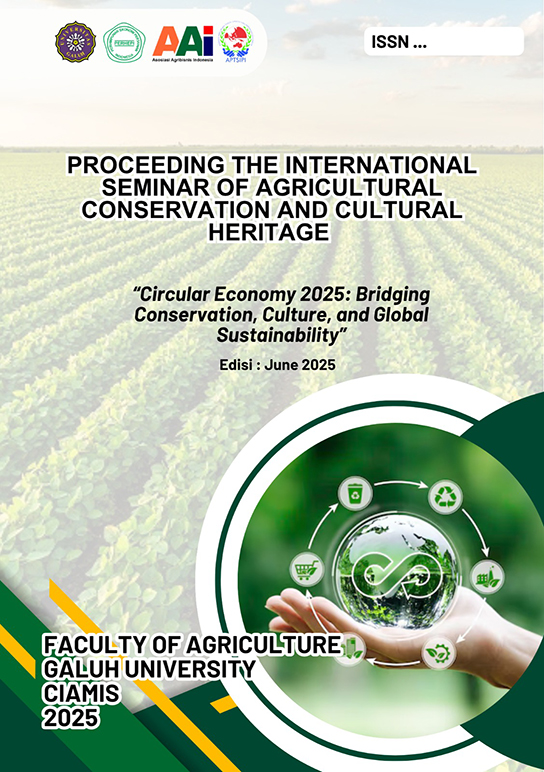SEAWEED AGRIBUSINESS IN A MINING-INFLUENCED REGION: A STUDY OF EUCHEUMA COTTONII QUALITY AND MARKETING IN KOLAKA, INDONESIA
Keywords:
Eucheuma cottonii, Mining-Influenced Region; Seaweed sustainability; Seaweed Agribusiness; Seaweed QualityAbstract
In Indonesia’s Southeast Sulawesi Province, Kolaka Regency ranks third in Eucheuma cottonii seaweed production. Developing Eucheuma cottonii agriculture in this region is hampered by the frequent overlap with state-owned and commercial mining operations, which degrades seaweed quality and ultimately impacts the agribusiness chain. This study aims to determine the agribusiness channels for Eucheuma cottonii and evaluate the quality of the seaweed grown by local seaweed farmers in Kolaka Regency’s mining districts. The study used a qualitative method to identify the agricultural channels and a quantitative method to evaluate the quality of seaweed by laboratory analysis. The findings demonstrate that, on average, the quality of Eucheuma cottonii samples collected in mining sites surpasses the threshold limitations established by the Indonesian National Standard (SNI). In these mining regions, seaweed farmers are at the head of the seaweed agribusiness chain, which then moves on to collectors, wholesalers, and processing. This study emphasizes that more mining regulations and increased agricultural productivity are required to preserve seaweed quality and advance sustainability.
References
1. J. W. Creswell and J. D. Creswell, Research Design: Qualitative, Quantitative, and Mixed Methods Approaches, 5th ed. (SAGE Publications, 2018).
2. N. K. Denzin, The Research Act: A Theoretical Introduction to Sociological Methods (Transaction Publishers, 2012).
3. M. B. Miles, A. M. Huberman, and J. Saldaña, Qualitative Data Analysis: A Methods Sourcebook, 3rd ed. (SAGE Publications, 2014).
4. L. A. Palinkas et al., Purposeful sampling for qualitative data collection and analysis in mixed method implementation research, Adm. Policy Ment. Health, 42, 533–544 (2015). https://doi.org/10.1007/s10488-013-0528-y
5. M. Q. Patton, Qualitative Research & Evaluation Methods, 4th ed. (SAGE Publications, 2015).
6. Kim, J. K., Yarish, C., Hwang, E. K., Park, M., & Kim, Y. (2017). Seaweed aquaculture: cultivation technologies, challenges and its ecosystem services. Algae, 32(1), 1–13. https://doi.org/10.4490/algae.2017.32.1.1
7. SNI 2690:2015, Dried Seaweed – Eucheuma cottonii (National Standardization Agency of Indonesia, 2015).
8. L. M. Aslan et al., Development of seaweed value chains in Indonesia, Mar. Policy, 115, 103868 (2020). https://doi.org/10.1016/j.marpol.2020.103868
9. D. G. Bourne et al., Sustainable global production of seaweed: Status and prospects, Trends Biotechnol., 33(11), 664–673 (2015). https://doi.org/10.1016/j.tibtech.2015.08.004
10. R. D. Putra et al., Heavy metal contamination in coastal areas impacted by mining, Environ. Monit. Assess., 192(2), 123 (2020). https://doi.org/10.1007/s10661-019-8035-5
11. D. Suharno et al., Environmental impact of nickel mining on coastal ecosystems in Indonesia, Ocean Coast. Manag., 207, 105613 (2021). https://doi.org/10.1016/j.ocecoaman.2021.105613
12. G. C. Trono, Seaweed farming in the Philippines and Southeast Asia: Progress and prospects, J. Appl. Phycol., 29(5), 2261–2270 (2017). https://doi.org/10.1007/s10811-017-1133-4
13. FAO, The Global Status of Seaweed Production and Utilization, FAO Fisheries and Aquaculture Technical Paper (Rome: FAO, 2018).
14. D. B. Largo et al., The effects of water quality on growth and carrageenan yield of Eucheuma cottonii, J. Appl. Phycol., 29(2), 917–925 (2017). https://doi.org/10.1007/s10811-016-0949-5
15. Y. Mulyati and R. M. Sari, Economic value chain of seaweed farming in Eastern Indonesia, IOP Conf. Ser.: Earth Environ. Sci., 370(1), 012022 (2019). https://doi.org/10.1088/1755-1315/370/1/012022
16. Radulovich, R., Umanzor, S., Cabrera, R., & Mata, R. (2015). Tropical seaweeds for human food, their cultivation and its effect on biodiversity enrichment. Aquaculture, 436, 40–46. https://doi.org/10.1016/j.aquaculture.2014.10.032


